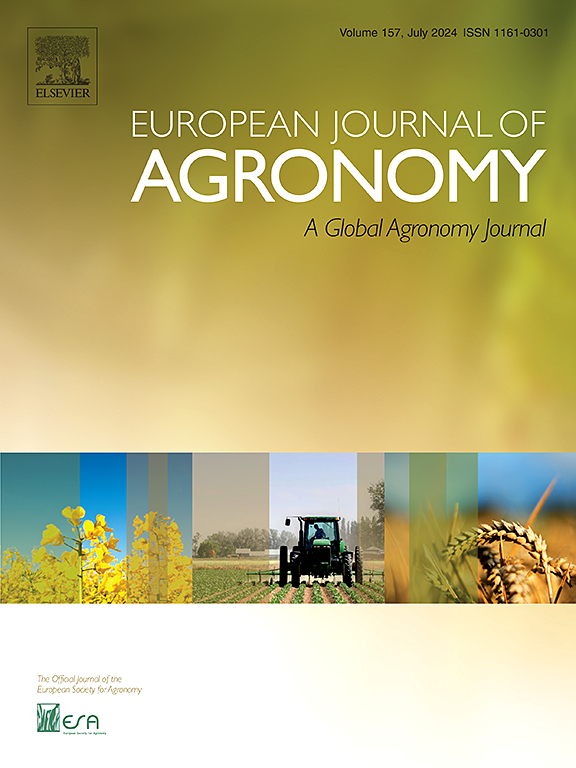UAV-based rice aboveground biomass estimation using a random forest model with multi-organ feature selection
IF 4.5
1区 农林科学
Q1 AGRONOMY
引用次数: 0
Abstract
Background
Aboveground biomass (AGB) is important for monitoring crop growth and field management. Accurate estimation of AGB helps refine field strategies and advance precision agriculture. Remote sensing with Unmanned Aerial Vehicles (UAVs) has become an effective method for estimating key parameters of rice.
Methods
This study involved four experiments conducted across varied locations and timeframes to collect field sampling data and UAV imagery. Feature extraction, including Vegetation Index (VI), textures, and canopy height, was performed. Key factors influencing biomass estimation across different rice organs were analyzed. Based on these insights, a Random Forest model was developed for AGB estimation.
Results
The VIS-Leaf factor-Spike factor-Stem factor (VIS-L-Sp-St) model proposed in this study outperformed traditional methods. The training set achieved an R2 of 0.89 with a reduced RMSE of 191.30 g/m2, surpassing the traditional VIS model (R2=0.64, RMSE=363.53 g/m2). Notably, in the validation set, the VIS-L-Sp-St model showed good transferability, with an R2 of 0.85 and RMSE of 196.55 g/m2, outperforming MLR (R2=0.02, RMSE=5944.09 g/m2), PLSR (R2=0.18, RMSE=934.27 g/m2) methods, BP (R2=0.14, RMSE=581.61 g/m2) method and SVM method((R2=0.45, RMSE=600.91 g/m2).
Conclusions
Sensitivity analysis showed that different rice organs respond differently to specific features. This insight improves feature selection efficiency and enhances AGB estimation accuracy. The organ-specific AGB estimation model highlights its potential to support precision agriculture and field management, contributing to advancements in agricultural research and application.
基于无人机的水稻地上生物量多器官特征选择随机森林模型估算
地上生物量(AGB)对监测作物生长和田间管理具有重要意义。准确估计AGB有助于改进田间策略和推进精准农业。无人机遥感技术已成为估算水稻关键参数的有效手段。方法在不同地点和时间框架进行了四项实验,收集了现场采样数据和无人机图像。特征提取包括植被指数(VI)、纹理和冠层高度。分析了影响水稻各器官生物量估算的关键因素。基于这些见解,开发了用于AGB估计的随机森林模型。结果本研究建立的vis -叶因子-穗因子-茎因子(VIS-L-Sp-St)模型优于传统方法。训练集的R2为0.89,RMSE为191.30 g/m2,优于传统的VIS模型(R2=0.64, RMSE=363.53 g/m2)。值得注意的是,在验证集中,visi - l - sp - st模型具有良好的可转移性,R2为0.85,RMSE为196.55 g/m2,优于MLR (R2=0.02, RMSE=5944.09 g/m2)、PLSR (R2=0.18, RMSE=934.27 g/m2)、BP (R2=0.14, RMSE=581.61 g/m2)和SVM (R2=0.45, RMSE=600.91 g/m2)方法。结论敏感性分析表明,水稻不同器官对特定特征的响应存在差异。这种洞察力提高了特征选择效率,提高了AGB估计的准确性。器官特异性AGB估计模型突出了其支持精准农业和田间管理的潜力,有助于农业研究和应用的进步。
本文章由计算机程序翻译,如有差异,请以英文原文为准。
求助全文
约1分钟内获得全文
求助全文
来源期刊

European Journal of Agronomy
农林科学-农艺学
CiteScore
8.30
自引率
7.70%
发文量
187
审稿时长
4.5 months
期刊介绍:
The European Journal of Agronomy, the official journal of the European Society for Agronomy, publishes original research papers reporting experimental and theoretical contributions to field-based agronomy and crop science. The journal will consider research at the field level for agricultural, horticultural and tree crops, that uses comprehensive and explanatory approaches. The EJA covers the following topics:
crop physiology
crop production and management including irrigation, fertilization and soil management
agroclimatology and modelling
plant-soil relationships
crop quality and post-harvest physiology
farming and cropping systems
agroecosystems and the environment
crop-weed interactions and management
organic farming
horticultural crops
papers from the European Society for Agronomy bi-annual meetings
In determining the suitability of submitted articles for publication, particular scrutiny is placed on the degree of novelty and significance of the research and the extent to which it adds to existing knowledge in agronomy.
 求助内容:
求助内容: 应助结果提醒方式:
应助结果提醒方式:


